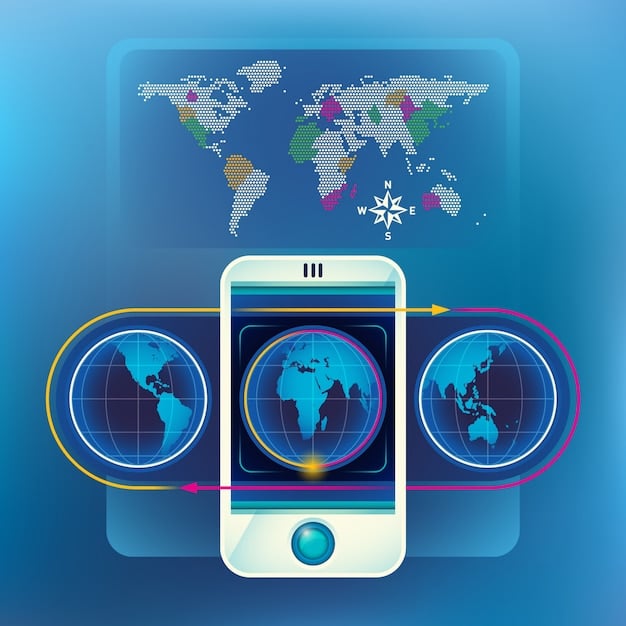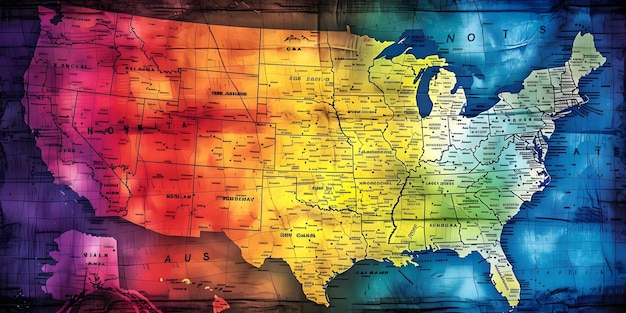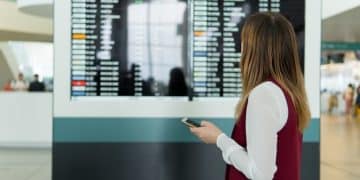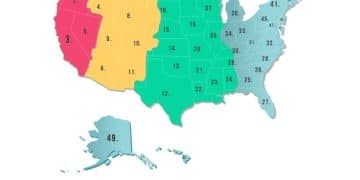US Travel Guide: Navigating Time Zones and Daylight Saving in 2025

US Travel Guide: Navigating Time Zones and Daylight Saving in 2025 provides essential insights for travelers planning trips within the United States, focusing on understanding and managing time zone changes and the complexities of Daylight Saving Time to ensure smoother and more enjoyable travel experiences.
Planning a trip within the United States in 2025? Navigating the various time zones and understanding the nuances of Daylight Saving Time can be tricky, but it’s essential for a smooth and enjoyable journey. This US Travel Guide: Navigating Time Zones and Daylight Saving in 2025 will equip you with the knowledge you need to confidently manage your travel plans.
From scheduling flights to coordinating meetings, being aware of these time-related factors can save you from unnecessary stress and ensure you arrive on time. Let’s dive in and make your 2025 US travel experience seamless!
Understanding US Time Zones
The United States spans several time zones, each affecting your travel schedule. Knowing these zones is crucial for accurate planning.
The Major US Time Zones
The contiguous United States has four primary time zones. Understanding these zones will help in planning any coast-to-coast journey.
- Eastern Time (ET): Covers states along the East Coast, including New York and Florida.
- Central Time (CT): Includes states in the Midwest and South, such as Illinois and Texas.
- Mountain Time (MT): Encompasses states like Colorado and Arizona.
- Pacific Time (PT): Covers the West Coast, including California and Washington.
Additionally, Alaska and Hawaii have their own time zones, Alaska Time (AKT) and Hawaii-Aleutian Time (HAT), respectively. Remember that Arizona does not observe Daylight Saving Time, except for the Navajo Nation.
Traveling across these time zones requires adjusting your watch and mentally preparing for the shift. Use online tools or smartphone apps to help keep track.

Daylight Saving Time in 2025: What to Expect
Daylight Saving Time (DST) can complicate travel planning, so it’s important to know how it works in the US in 2025.
When Does Daylight Saving Time Start and End in 2025?
In the US, Daylight Saving Time typically begins on the second Sunday in March and ends on the first Sunday in November. For 2025, these dates are:
- Start Date: March 9, 2025
- End Date: November 2, 2025
On March 9th, clocks are moved forward one hour at 2:00 AM local time. On November 2nd, clocks are moved back one hour at 2:00 AM local time. Mark these dates in your calendar to avoid confusion during your travels.
States That Do Not Observe Daylight Saving Time
Most of the US observes DST, but there are exceptions. Knowing which states don’t participate is crucial when planning trips.
Arizona (except for the Navajo Nation) and Hawaii do not observe Daylight Saving Time. This means that these states remain on standard time year-round. Guam, Puerto Rico, and the Virgin Islands also do not observe DST.
The Impact of Time Changes on Travel Schedules
Time changes can significantly impact travel schedules, potentially causing missed flights and scheduling conflicts. Understanding these impacts is crucial for effective planning with your US Travel Guide: Navigating Time Zones and Daylight Saving in 2025.
Adjusting Flight Schedules
When booking flights, pay close attention to the arrival and departure times and their corresponding time zones. Double-check whether Daylight Saving Time will be in effect during your travel dates.
Always confirm flight times with the airline a few days before departure. Keep in mind that even a one-hour time difference can lead to missed connections or scheduling issues if not properly accounted for.
Coordinating Meetings and Appointments
If your travel involves business meetings or appointments, clearly communicate the time zone when scheduling. Use online scheduling tools that automatically convert times to different time zones to minimize confusion.
For instance, a meeting scheduled for 10:00 AM Eastern Time is 7:00 AM Pacific Time. Miscommunication can lead to serious professional setbacks.
Tips for Minimizing Time Change Disruptions
Traveling across time zones can be disruptive, but there are strategies to minimize these effects, making your US Travel Guide: Navigating Time Zones and Daylight Saving in 2025 even more valuable.
Pre-Travel Preparation
Several steps can be taken before your trip to ease the transition into a new time zone.
- Adjust Sleep Schedule: Start adjusting your sleep schedule a few days before your trip. Go to bed and wake up earlier or later, depending on which direction you are traveling.
- Stay Hydrated: Drink plenty of water during your flight to combat dehydration, which can worsen the effects of jet lag.
- Avoid Alcohol and Caffeine: Refrain from consuming alcohol and caffeine during the flight as they can disrupt your sleep patterns.
On-Arrival Strategies
Once you arrive at your destination, there are more ways to adapt to the new time zone:
- Expose Yourself to Sunlight: Sunlight helps regulate your body’s natural sleep-wake cycle.
- Eat Meals at Local Times: Adjust your meal times to align with the local schedule to help reset your body clock.
- Stay Active: Engage in light physical activity to boost your energy levels and reduce fatigue.

Utilizing Technology to Manage Time Zone Differences
In today’s digital age, technology offers numerous tools to help manage time zone differences and the impact of Daylight Saving Time. Our US Travel Guide: Navigating Time Zones and Daylight Saving in 2025 recommends these apps and tools.
Smartphone Apps and Online Tools
Many apps can assist in tracking multiple time zones, setting reminders, and planning schedules.
Apps like World Clock, Time Zone Converter, and Every Time Zone are invaluable for travelers. These tools allow you to easily convert times, schedule meetings, and stay organized.
Setting Up Travel Alerts
Stay informed about any changes to your travel plans by setting up alerts and notifications.
Most airlines and travel agencies offer mobile apps that send real-time updates about flight schedules, delays, and gate changes. Enable push notifications to receive timely alerts, ensuring you’re always in the loop.
| Key Point | Brief Description |
|---|---|
| ⏰ Time Zones | US has multiple time zones; adjust accordingly. |
| ☀️ Daylight Saving | Starts Mar 9, 2025; ends Nov 2, 2025. |
| ✈️ Flight Schedules | Confirm times and time zones before flying. |
| 📱 Tech Tools | Use apps for schedules and alerts. |
Frequently Asked Questions
The main time zones are Eastern Time (ET), Central Time (CT), Mountain Time (MT), and Pacific Time (PT). Alaska and Hawaii have their own time zones as well.
In 2025, Daylight Saving Time starts on March 9th and ends on November 2nd. Remember to adjust your clocks accordingly on these dates.
Arizona (except for the Navajo Nation) and Hawaii do not observe Daylight Saving Time. They remain on standard time year-round.
Adjust your sleep schedule before your trip, stay hydrated, expose yourself to sunlight, and eat meals at local times to minimize jet lag.
Use smartphone apps like World Clock and Time Zone Converter. Also, set up travel alerts from airlines to stay informed about any schedule changes.
Conclusion
Understanding and managing time zones and Daylight Saving Time is crucial for successful travel planning within the United States. By following this US Travel Guide: Navigating Time Zones and Daylight Saving in 2025, you’ll be well-prepared to handle any time-related challenges.
Armed with this knowledge and the right tools, you can ensure smoother travel experiences and avoid unnecessary stress. Happy travels in 2025!





